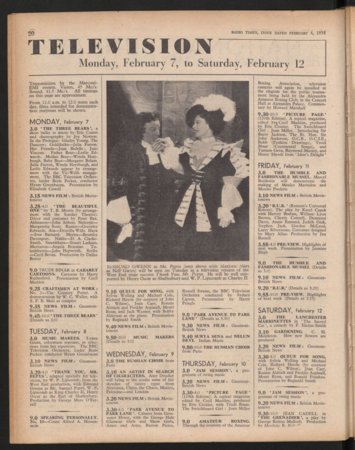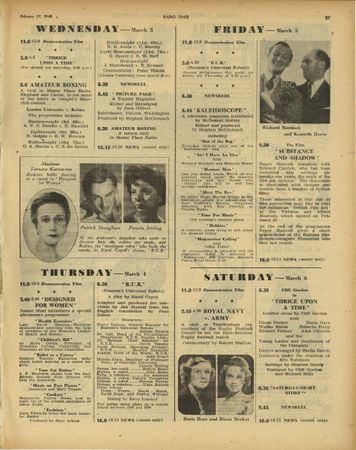R.U.R. (lost BBC television adaptations of science-fiction play; 1938; 1948)
R.U.R. (Rossumovi Univerzální Roboti) is a science-fiction drama play written by Karel Čapek. A Czech Republic work established in 1920, the play is historic for inventing the English word "robot". In 1938, the BBC adapted the play to television, which is considered by some sources as the earliest science-fiction television program. The BBC also broadcast another adaptation of the play in 1948.
Background
Written by Karel Čapek, R.U.R. served as a cautionary tale regarding humanity's growing obsession with mechanisation, which contributed to the production of various technological horrors during the First World War.[1][2][3][4] In the play, Mr. Rossum and his nephew successfully invent a substance that enables them to create artificial life: the roboti.[1][4][3] However, whereas Mr. Rossum saw the project simply as means of verifying the existence of God, his nephew betrays him in favour of producing thousands of roboti to serve industrial needs, and in turn allow him to become rich.[1][3] The Czech word robota is the definition of servitude forced labour, and is the inspiration for the English word "robot".[5][6][1][3] Čapek obtained the word from his older brother, cubist painter Josef Čapek, after initially debating on whether to call them the Labori.[6] The roboti are not exactly the same as the robots depicted in future science-fiction works or in real-life.[5] Rather, they are more akin to androids, for they are humanoid entities existing within artificial flesh.[7][5] Comparisons between R.U.R. and Mary Shelley's Frankenstein were made, including how both involve creating artificial life that later rebels against their masters.[1][2][4]
The play is split into three acts; in the first, occurring around the year 2000 and about 70 years after the substance was discovered, R.U.R. has successfully introduced numerous roboti across the world.[4][3][1] In fact, these now-cheap artificial entities are vital for current industrial needs and are almost completely identical to humans.[4][3] Despite this, they essentially remain slaves to humanity.[4][3][1] The League of Humanity, led by Helena Glory, reaches the R.U.R. island and attempts to convince R.U.R. to have the roboti receive greater freedom and rights, but their demands are dismissed by the organisation's human directors who see roboti as mere machines in humanity's arsenal.[4][3][1] A decade passes by Act 2, as humanity declines following their society's growing overreliance on mechanisation, the birth rate considerably declining as increasing numbers of women become infertile.[4][3][1] Another issue is that many roboti are now "malfunctioning" and are turning against the humans they once loyally served.[4][3][1] Meanwhile, Glory meets Dr. Gall, who establishes roboti with full human emotions and traits, creating a male robota called Radius, and a female robotess named after Helena.[4][3] However, Radius has also begun realising the predicament humanity has placed on him and the other roboti.[4][3] After being freed from certain destruction by a sympathetic Helena, Radius leads a rebellion against the humans and begins taking over the world.[4][3]
In Act 3, the roboti attack the R.U.R. factory, with a peace negotiation based on bribery falling through.[4][3] Eventually, the roboti drive humanity to near-extinction, but not before Helena reveals she destroyed Rossum's documents which contained the roboti formula.[4][3] Thus, they spare the life of one human, R.U.R.'s mechanical engineer Alquist, on the condition he reinvent the formula.[4][3][2] Ultimately, he is unable to find a solution after a year of attempts, and refuses the roboti's order for him to dissect them with the intent of allowing them to reproduce.[4][3] Meanwhile, robotess Helena falls in love with Primus, and have virtually transcended into near-humans themselves.[4][3][2] After both are willing to sacrifice themselves to save the other and in turn their species, the play concludes with the couple declared as Adam and Eve by Alquist, who urges them to become the world's new hope for the future.[4][3]
BBC Television Adaptations
R.U.R. became a major success within its home country and across the world.[8][1][2][3][4] Its concepts are therefore the basis for science-fiction works like Blade Runner, The Matrix, and The Terminator, which primary feature robots, artificial intelligence, and subsequent rebellions from the machines humanity has created.[9][10][8][1] Therefore, it became a prime target for the BBC to air an adaptation for its fledgling Television Service.[11][8][9][10] On 11th February 1938, the BBC televised a 35-minute abridged version of the play produced by Jan Bussell, featuring names such as Harvey Braban, William Lyon Brown, and Cherry Cottrell.[12][11][8][9] Originally airing at 3:20 pm, it was also repeated later that evening at 9:20 pm.[12][11][10][8][9] Prior to this, a trailer was aired live twice seven days prior to the broadcast, featuring the characters Domain, Helena and Radius.[11] Additionally, issue 748 of Radio Times believed the play and the special effects it required would be best suited for television.[13][10][9][11]
The 14th February 1938 issue of The Times agreed that the adaptation was "a good choice for television", though, in also criticising the play it was based on, criticised the Adam and Eve scene for being misplaced in an otherwise brutal story.[11] The roboti's depicted in the adaptation also considerably deviated from the near-human appearances in the original play, resembling more so the traditional robot look featured in future science-fiction shows.[11][8] Other reviews focused on the show's special effects, a key component for later science-fiction productions.[10][11] Because of the limited range from the BBC's television transmitter housed at Alexandra Palace and the expense of early televisions, only a small audience within North London were able to watch it.[8] But while the 1938 television adaptation was initially largely forgotten, contemporary accounts such as from the Smithsonian Magazine indicate that it was historic for being the first science-fiction television program, in an experimental period for the BBC and drama television overall.[9][11][8][10]
Three years following the Second World War, another adaptation, this time a 90-minute production airing live once on 4th March 1948, was broadcast.[14][11] Again produced by Bussell, the work somewhat suffered from a reduction in special effects and other limitations reflecting the BBC's desire to appeal to a more general, less intellectual viewing audience as television slowly became more popular.[14][11] Another key change was the roboti's appearance; while a surviving photograph certainly reflected their near-resemblance to humanity, most wore mere black loin cloths and sandals to reflect the key importance of flesh within the play.[11] Also of note was that Radius was portrayed by Patrick Troughton, who would later star as the Second Doctor in the BBC's biggest science-fiction series, Doctor Who.[11][14][9]
Availability
Ultimately, the two adaptations were broadcast live in a period where television recordings seldom occurred until the advent of videotape recording in 1958.[15][16][11] Therefore, no footage from either, nor from the 1938's trailers, is believed to have been among the extremely limited surviving pre-Second World War BBC television coverage. Nevertheless, photographs and Radio Times issues help to document them both.[11][8][12][14][10]
Gallery
Images
External Links
- British Film Institute listing of the 1938 adaptation.
- IMDB page for the 1938 adaptation.
- British Film Institute listing of the 1948 adaptation.
- IMDB page for the 1948 adaptation.
References
- ↑ 1.00 1.01 1.02 1.03 1.04 1.05 1.06 1.07 1.08 1.09 1.10 1.11 The MIT Press Reader detailing the creation, summary, and influence of R.U.R. Retrieved 29th Mar '23
- ↑ 2.0 2.1 2.2 2.3 2.4 The Guardian reflecting on R.U.R. a century after its creation, and summarising its connections with modern science-fiction and robotics of today. Retrieved 29th Mar '23
- ↑ 3.00 3.01 3.02 3.03 3.04 3.05 3.06 3.07 3.08 3.09 3.10 3.11 3.12 3.13 3.14 3.15 3.16 3.17 3.18 3.19 Encyclopedia detailing the themes, plot, and success of R.U.R.. Retrieved 29th Mar '23
- ↑ 4.00 4.01 4.02 4.03 4.04 4.05 4.06 4.07 4.08 4.09 4.10 4.11 4.12 4.13 4.14 4.15 4.16 4.17 4.18 Super Summary providing a plot summary. Retrieved 29th Mar '23
- ↑ 5.0 5.1 5.2 The Free Dictionary definition of "robot". Retrieved 29th Mar '23
- ↑ 6.0 6.1 Robotics Academy detailing the inspiration for "robot", and how it got ushered into R.U.R.. Retrieved 29th Mar '23
- ↑ Collins Dictionary definition of "android". Retrieved 29th Mar '23
- ↑ 8.0 8.1 8.2 8.3 8.4 8.5 8.6 8.7 8.8 Television Heaven detailing R.U.R.s 1938 BBC adaptation and its generally forgotten status in science-fiction television history. Retrieved 29th Mar '23
- ↑ 9.0 9.1 9.2 9.3 9.4 9.5 9.6 Smithsonian Magazine detailing the 1938 television adaptation and declaring it the first science fiction television program. Retrieved 29th Mar '23
- ↑ 10.0 10.1 10.2 10.3 10.4 10.5 10.6 Ian Visits detailing the 1938 adaptation, and how most reviews focused on its special effects. Retrieved 29th Mar '23
- ↑ 11.00 11.01 11.02 11.03 11.04 11.05 11.06 11.07 11.08 11.09 11.10 11.11 11.12 11.13 11.14 Genre, Taste and the BBC: The Origins of British Television Science Fiction providing a detailed analysis and photographs of both adaptations. Retrieved 29th Mar '23
- ↑ 12.0 12.1 12.2 Issue 749 of Radio Times detailing the two broadcasts of the 1938 adaptation. Retrieved 29th Mar '23
- ↑ Issue 748 of Radio Times briefly previewing the 1938 adaptation. Retrieved 29th Mar '23
- ↑ 14.0 14.1 14.2 14.3 Issue 1,272 of Radio Times detailing the broadcast of the 1948 adaptation. Retrieved 29th Mar '23
- ↑ Web Archive article discussing how most early television is missing due to a lack of directly recording television. Retrieved 29th Mar '23
- ↑ Science and Media Museum noting when videotape recording started in the United Kingdom. Retrieved 29th Mar '23


